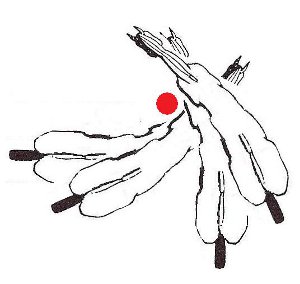Turn on the fore hand

In the fore hand turn the horse's shoulders shall walk forward in a very small circle
The turn on the forehand is a misprized exercise. As it is the first exercise many riders meet when they first start riding, I think it has got a reputation as a beginner's exercise so most riders won't ride it as that may make them look as a beginner. I, however, love it, just because it is so plain and easy to do, for beginners and for the horses.
In this article I will not talk about the rider's education, only about the horse.
You can use the exercise in many levels of the horse's education, and you put different demands on the result depending on the situation.
What everyone knows about the forehand turn is that the inner foreleg shall walk on place, up and down. There is less discussion about what the other three legs are supposed to do. Everyone also knows that for a young horse it is not important that the inner foreleg is on place, but it is never said what it shall do instead. Those inexact statements gives me a lot of freedom to make my own interpretation of the exercise.
First time we use the forehand turn is to teach the young horse to walk away from pressure from our leg. If we press with our left leg the horse is supposed to move/yield his hind to the right. This is the basic idea with the forehand turn: Teach the horse how to obey the pressure from a single leg.
At this premature stadium we don't care about anything else than that the horse walks away from pressure with his hind. There is no idea to avoid moving of the fore hand: There is never a good idea to tell the horse what not to do.
All non wanted things the horse does first time we ask him about a new exercise is his guesses what we may want. He tries to figure out what we do and try different solutions It is not good blaming or punishing him for guessing or trying even if he do wrong. Better is to encourage him till he guesses right and then reward him. Though, if the horse walks away forward INSTED of yielding, then we may stop him.
However: Most riders are so eager about making the turn with the forehand on place that they give a of aids preventively; most often they brake much more than needed. This often makes the horse frustrated as whatever he does he is told not to do, and he looses his impulsion. It is quite common that horses moves slightly backwards with the forehand during the turn, and that is a result of a to strong pulling and braking rein.
A pulling rein also makes that the horse loose his impulsion, and maybe that is one of the reasons for the bad reputation of the exercise: It kills the horses mind. This is only true however, if we kill it.
There we find the second reason to ride the forehand turn: To teach the horse to yield under impulsion. Then we must let the horse take small steps forward with fore hand. Now remember what I wrote above: The young horse is not supposed to walk on place with the forehand during the turn. The centered turn is not for education: It is for getting high point at a dressage show – to brag. I always prefer to make a bigger turn, instead of the narrow centered on place turn, also on educated horses as we then get a much more useful exercise.
To reach this goal, I use some devise as a turning point, that shall be inside the horses inner shoulder so he can walk on a small circle with the fore hand and yield on a bigger one with the hind.
While riding slightly forward during the turn, we reach the third goal of the exercise: To subtle the horse. Now the horse must yield his inner hind leg as he does in other lateral works: Swing it forward in under the belly and place it under the point of weight. The is a long stride. To do that the horse use to put his inner hip forward. Then it is easier to reach the point of weight. To move the inner hip forward he have to move the outer hip backwards. To do that he have to relax and stretch the back muscles on the outer side. Then we get a subtle bent and gymnastic horse wile riding such a plain exercise as the forehand turn.
